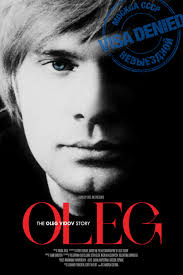
OLEG: THE OLEG VIDOV STORY
US, 2022, 90 minutes, Colour.
Narration by Brian Cox.
Directed by Nadia Tass.
Most audiences will initially ask who is Oleg? Who is Oleg Vidov? It will certainly enjoy the 90 minutes of answer here.
There are three strands of Oleg’s story intertwined, his cinema history, the experiences of life in the Soviet Union, the dimensions of his personal life.
For cinema buffs, his cinema history will be something of a treat. He began to get screen roles in his early 20s, in the 1960s, quickly becoming popular because of his screen presence, the variety of roles, good-looking, dubbed the Russian Robert Redford. Magazine articles, fans… What is particularly interesting is the range of clips from the Russian films of the 60s and 70s, unfamiliar to Western audiences, something of a revolution in their themes and style. And, throughout, there are interviews with a range of Russian directors as well as actors and actresses.
While there was success, there was the ideology of the use of film, dating from Lenin and his enthusiasm, propaganda for the Soviet Union, instruction for the audiences in socialism. Somewhat stifling for the creative film community.
Another interesting aspect is the beginning of international collaboration, Oleg’s scouted for a Danish film, The Red Mantle, his first trip abroad, its openness a bit of a shock to his Russian colleagues. More acceptable was filming in Tito’s Yugoslavia in 1967, working with stars like you will bring and Orson Welles, the Battle of Neretva. There are also glimpses of 1970s Waterloo with Rod Steiger and Oleg portraying an English soldier.
After his moving to the United States, he appeared in a number of films, this documentary inserting a clip from Red Heat, co-starring with Arnold Schwarzenegger, then his playing the role of the Russian Undersecretary of the United Nations in the missiles of October drama, with Kevin Costner, 13 Days.
One of his substantial contributions to cinema culture was his getting the rights to a wide range of Russian animation from the past, some of the films that he grew up with. With his wife, Joan Borsten, he persuaded celebrities like Mikael Baryshnikov to support their restoration, dubbing (with stars like Bill Murray and Charlton Heston), their being shown on television. However, a Russian company, taking the name of the previous company, sued for the rights to these films, difficult times in courts, appeals, but judgement finally on the side of Oleg and his wife.
Those of a more historical/sociological frame of mind will be interested in Russia, Oleg’s first decade, born in 1943, was under the dictatorship of Stalin, pressured atmosphere, especially after the end of the war, the Iron Curtain, the cutting off of Russians from the rest of the world, the arts heavily censored, depending on Stalin’s approval, a flourishing film industry but at the service of the state. Oleg’s early years of cinema were of the Kruschev era but, then in the return to repressive government by Brezhnev. As indicated, Oleg experienced repression leading to his escaping, defecting, and finding his way to the United States.
There is also then, underlying everything, Oleg’s personal life. There was his dependence on his mother, staunchly Communist, responsible jobs which included travel, including to China and Mongolia, Oleg having to live with his aunt in Khazakstahn. There is a return to Russia, poor, his mother’s mental collapse, taking him to see the movies, kindling the ambition to be an actor, some difficulties in getting into the school, work, final acceptance, and the beginning of his career and quick move to popularity. (And the information that many of the popular films, including American, were confiscated from Goebbels’ collection in Berlin.)
He encountered Brezhnev’s daughter and her close friend, an actress,fell in love with her, eventually getting permission to marry, their having a child, the Brezhnev influence and getting them a more upmarket apartment. But his wife was used to having every comfort and made continuous demands on her husband, eventually a divorce being arranged behind his back. With his experience of working in Yugoslavia and the law allowing married couples to live in different parts of the Soviet Union and Communist countries, he went through an arranged marriage and moved to Yugoslavia. With the urging of a co-star who could move comfortably between Yugoslavia and Austria, getting his passport, he escaped (a comic scene where the border guards are watching a football match and just as a goal was scored, their being waved through).
He was very successful in America, many articles about him, television interviews, some film roles, and encouraged by the director of Red Heat, Walter Hill, some film roles. However, he encountered and was helped by the daughter of a critic, a journalist, Joan Borsten. They married in 1989, happy life, charity work, and the promotion of Russian animation as mentioned previously.
Home movies of his final years, happy marriage, life in California, his final cancer – but, the unexpected joy of making contact with his son who moved to the United States and then, the discovery of another son from a liaison he had had in the 1970s.
The film was directed by Nadia Tass, celebrated Australian director (Malcolm, Amy). She was personally selected for the direction by Joan Borsten herself.